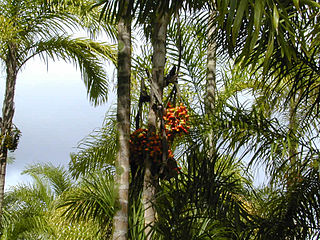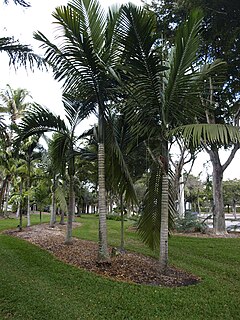
Bactris is a genus of spiny palms which are native to Mexico, South and Central America and the Caribbean. Most species are small trees about 2 m tall, but some are large trees while others are shrubs with subterranean stems. They have simple or pinnately compound leaves and yellow, orange, red or purple-black fruit. The genus is most closely related to several other spiny palms—Acrocomia, Aiphanes, Astrocaryum and Desmoncus. The fruit of several species is edible, most notably B. gasipaes, while others are used medicinally or for construction.

Colpothrinax is a genus of palms native to Central America and the Caribbean. Colpothrinax is a member of subfamily Coryphoideae, tribe Trachycarpeae, although its placement within the subtribe is uncertain, on the basis of plastid DNA

Desmoncus is a genus of mostly climbing, spiny palms native to the Neotropics. The genus extends from Mexico in the north to Brazil and Bolivia in the south, with two species present in the southeastern Caribbean.

Archontophoenix is a plant genus comprising six palm species that are native to New South Wales and Queensland in eastern Australia. They are tall, slender and unbranched. Relationships between Archontophoenix and the other genera of subtribe Archontophoenicinae, including the New Caledonia endemic Actinokentia, Chambeyronia and Kentiopsis are unresolved.

Actinokentia is a genus of flowering plants in the family Arecaceae, comprising two species, both indigenous to New Caledonia. Relationships between Actinokentia and the other genera of subtribe Archontophoenicinae, including the Australian Archontophoenix and the New Caledonia endemic Chambeyronia and Kentiopsis are unresolved.

Asterogyne is a genus of flowering plant in the family Arecaceae native to Central America and northern South America, with three of the five known species endemic to Venezuela.

Basselinia is a genus of flowering plant in the family Arecaceae. The entire genus is endemic to the Island of New Caledonia in the Pacific. In some molecular phylogenetic analyses, Hedyscepe from Lord Howe Island is nested in Basselinia.

Chambeyronia is a genus of flowering plants in the family Arecaceae. It contains the following species, both endemic to New Caledonia: Relationships between Chambeyronia and the other genera of subtribe Archontophoenicinae, including the Australian Archontophoenix and the New Caledonia endemic Actinokentia and Kentiopsis are unresolved.
Cyphosperma is a genus of flowering plants in the family Arecaceae, native to various islands of the Pacific. It contains the following species:

Cyrtostachys is a genus of flowering plant in the family Arecaceae. Its species are found in southeast Asia, New Guinea, and in some of the South-Central and Southwest Pacific island habitats of the Oceanian realm.

Hedyscepe canterburyana, the big mountain palm or umbrella palm, is the sole species in the genus Hedyscepe of the family Arecaceae. It is endemic to Lord Howe Island, Australia and is threatened by habitat loss. It is a solitary palm with a distinct crownshaft, and bears unisexual flowers of both sexes. With the Rhopalostylis palms of Norfolk Island and New Zealand it forms the botanic subtribe Rhopalostylidinae. If differs from Rhopalostylis in minor floral details including having more than six stamens, and in being protandrous rather than protogynous. The two genera were formerly included in Archontophoenicinae until a recent revision. In some molecular phylogenetic analyses, Hedyscepe was found to be nested in the New Caledonia endemic Basselinia.

Kentiopsis is a genus of palm trees endemic to New Caledonia. Relationships between Kentiopsis and the other genera of subtribe Archontophoenicinae, including the Australian Archontophoenix and the New Caledonia endemic Chambeyronia and Actinokentia are unresolved.
Clinosperma macrocarpa is a species of palm tree known from a single population at around 500 metres (1,600 ft) altitude on Mont Panié, New Caledonia. It was described as the only species in the genus Lavoixia, but has since been moved to genus Clinosperma. It is listed as critically endangered on the IUCN Red List.
Physokentia is a genus of flowering plant in the palm family, native to certain islands of the western Pacific.

Xanthostemon is a genus of trees and shrubs, constituting part of the myrtle plant family Myrtaceae. This genus was first described in 1857 by German–Australian botanist Ferdinand von Mueller. According to different official sources between 46 and 51 species are known to science. They grow naturally in New Caledonia, Australia, the Solomon Islands and Malesia, including the Philippines, New Guinea and Indonesia. The genera Pleurocalyptus and Purpureostemon from New Caledonia are morphologically close to Xanthostemon.

Burretiokentia is a genus of palms (Arecaceae) endemic to New Caledonia containing five species. The relationships between Burretiokentia and some other genera of the tribe Basseliniinae including Physokentia and the New Caledonia endemic Cyphophoenix are not clear.

Cyphokentia is a genus of flowering plant in the palm family endemic to New Caledonia. the genus is named from two Greek words meaning "tumor" and "Kentia", a former palm genus, and the species name translates to "large" and "spike", describing the inflorescence. The genus has two known species and Its closest relative is Clinosperma, also endemic to New Caledonia,. and sole other genus of subtribe Clinospermatinae.

Archontophoenicinae is a botanical subtribe consisting of four genera of palms, namely Archontophoenix from Queensland and New South Wales and Actinokentia, Chambeyronia and Kentiopsis from New Caledonia. Phylogenetic relationships between the four genera are unresolved.

Rhopalostylidinae is a botanical subtribe consisting of two genera of palms from Australia and New Zealand, Hedyscepe and Rhopalostylis. These two genera were formerly included in Archontophoenicinae, to which they are morphologically similar, until a recent revision.
Clinosperma is a palm tree genus in the family Arecaceae.

















